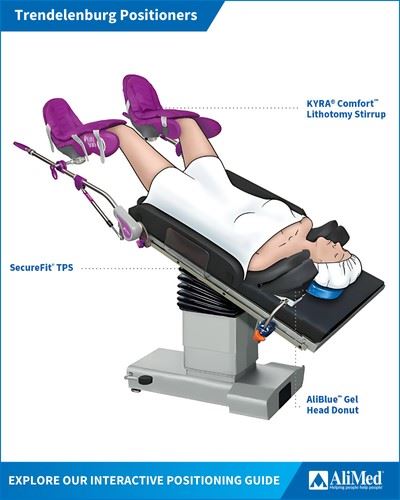-
Home
-
Proper Patient Positioning Guidelines: Trendelenburg Position
Proper Patient Positioning Guidelines: Trendelenburg Position
October 23, 2024

The Trendelenburg position is a widely utilized technique in medical procedures, involving tilting the operating table so that the patient's head is positioned lower than their feet. Named after the German surgeon Friedrich Trendelenburg, this position enhances surgical access to the lower abdomen and pelvis, providing surgeons with better visibility and ease during operations. It is particularly beneficial in surgeries requiring optimal exposure of pelvic organs, in managing hypovolemic shock by improving venous return and increasing cardiac output and is crucial in robotic surgeries where clear visibility and precision are essential.
Vigilant monitoring throughout the procedure is crucial to ensure patient safety. Respiratory monitoring is essential because, in the Trendelenburg position, abdominal organs may press against the diaphragm, potentially impacting breathing and blood flow. Perioperative nurses and the surgical team should watch for signs of respiratory compromise and adjust positioning if necessary.
Cardiovascular monitoring is also important. The Trendelenburg position can increase central venous pressure and may affect cardiac output. Close observation of blood pressure and heart rate allows for timely adjustments to the patient's position or anesthesia management. Regularly checking and padding all potential pressure points helps prevent pressure ulcers.
All position adjustments should be made slowly to allow the patient's body to adapt, minimizing risks associated with sudden shifts in blood volume and pressure. Continuous communication among the surgical team is vital to address any concerns promptly.
Patient Positioning in Trendelenburg: Head and Neck
Proper support and alignment of the head and neck are critical to prevent complications during surgery. The patient's head should be supported by a specialized headrest that maintains alignment with the spine. This support helps reduce the risk of increased intracranial pressure and intraocular pressure, which is especially important for patients with head injuries or neurological conditions. Ensuring the neck is in a neutral position, avoiding excessive flexion or extension, minimizes strain on cervical vertebrae, and helps maintain airway patency.
Patient Positioning in Trendelenburg: Arms and Upper Body
Correct positioning of the arms and upper body is essential to prevent nerve injuries and ensure patient comfort. When the patient's arms are positioned at their sides, they should be placed snugly alongside the body with palms facing inward toward the thighs. Padded elbow protectors can cushion the ulnar nerve area, and the arms can be secured with a draw sheet or arm sleds to prevent movement without restricting circulation.
If armboards are used, the arms should be positioned at an angle less than 90 degrees from the body to avoid stretching or compressing the brachial plexus. The palms should face upward (supinated) to reduce pressure on the radial and ulnar nerves. Armboards must be well-padded, and straps or restraints should not be too tight to prevent circulation issues.
Shoulder bracing should be avoided if possible due to the risk of brachial plexus injury. If shoulder braces are necessary, they must be positioned correctly over the acromion process, not on the soft tissues or muscles of the shoulder. Utilizing supportive devices like the SecureFit TPS or Single-Use Trendelenburg Stabilizer can help secure the patient without exerting harmful pressure on nerves, minimizing movement and lowering the risk of injury.
Patient Positioning in Trendelenburg: Legs and Lower Body
Stabilizing the legs and lower body is essential to ensure patient safety and prevent undue strain. The lower section of the operating table should be adjusted so the patient's knees are slightly flexed and rest over the table's lower break, keeping the legs parallel to the floor. This setup promotes even weight distribution and reduces stress on joints and the lower back.
Padding should be placed under the heels to prevent pressure ulcers, and padded footrests or straps can be used to prevent the patient from sliding downward due to gravity. It is crucial to make these adjustments slowly, giving the patient's body time to adapt to changes in blood volume distribution, blood pressure, and respiratory mechanics. During position changes, the surgical team should observe for signs of hemodynamic instability or respiratory compromise.
Preventing Brachial Plexus Injury
A significant concern when using the Trendelenburg position is the risk of brachial plexus injury due to improper positioning. To prevent excessive stretching or compression of the shoulder area, care must be taken in aligning and securing the patient. If shoulder braces are used, they should be aligned correctly against the acromion process and the spine of the scapula to prevent excessive pressure on the brachial plexus nerves.
The Trendelenburg position is a vital tool in modern medicine, enhancing access to pelvic and lower abdominal organs while also being beneficial in specific medical conditions like hypovolemic shock. Proper patient positioning, vigilant monitoring, and the use of supportive devices are essential to maximize the benefits of this position while minimizing risks such as nerve injuries and respiratory complications. By adhering to these guidelines, healthcare professionals can improve patient outcomes and maintain the highest standards of perioperative care.
More Resources for Trendelenburg and Other Surgical Positions
AliMed has a wide range of reusable and disposable surgical positioning products to aid with proper patient positioning while helping reduce pressure, shear, and nerve injuries during supine procedures.
Explore our interactive Trendelenburg Patient Positioning Page or browse our comprehensive guide for more patient positioning products and resources for supine and other common surgical positions, including lateral, prone, lithotomy, fowler’s, supine, reverse Trendelenburg, and spinal.
You may also be interested in: